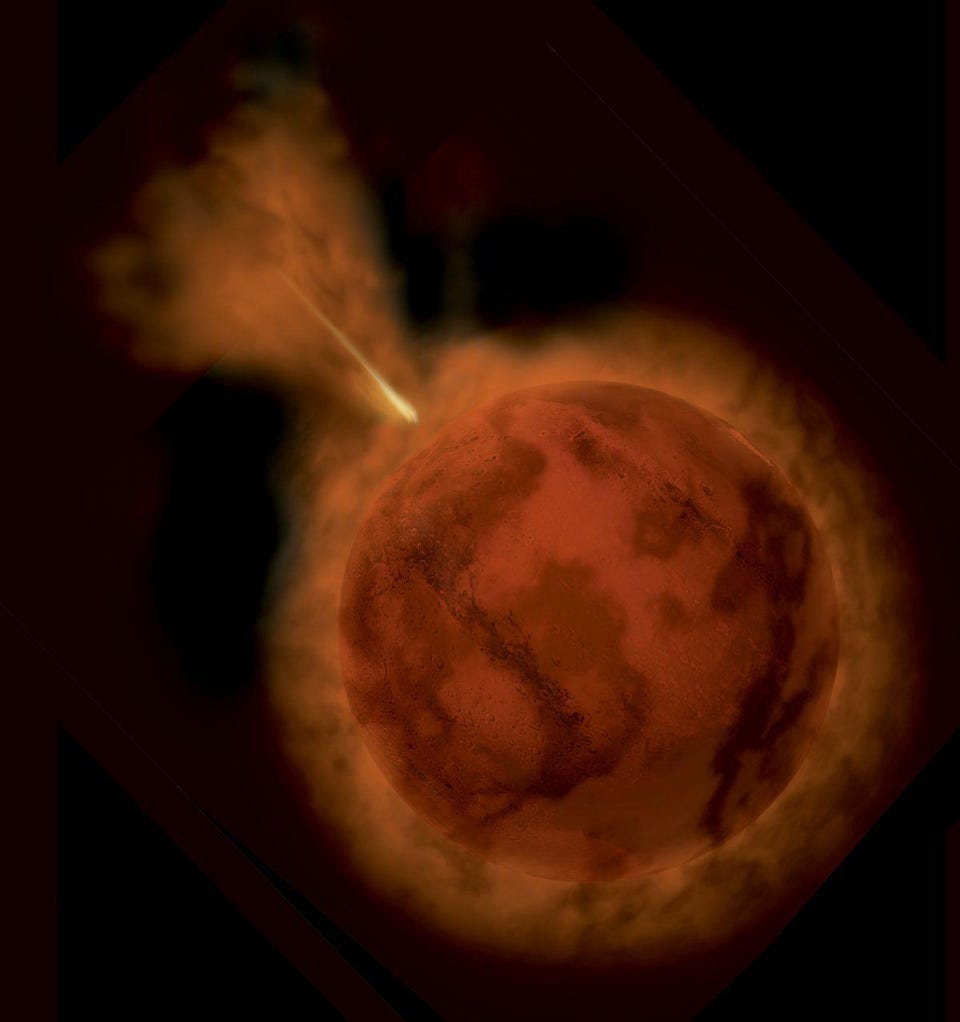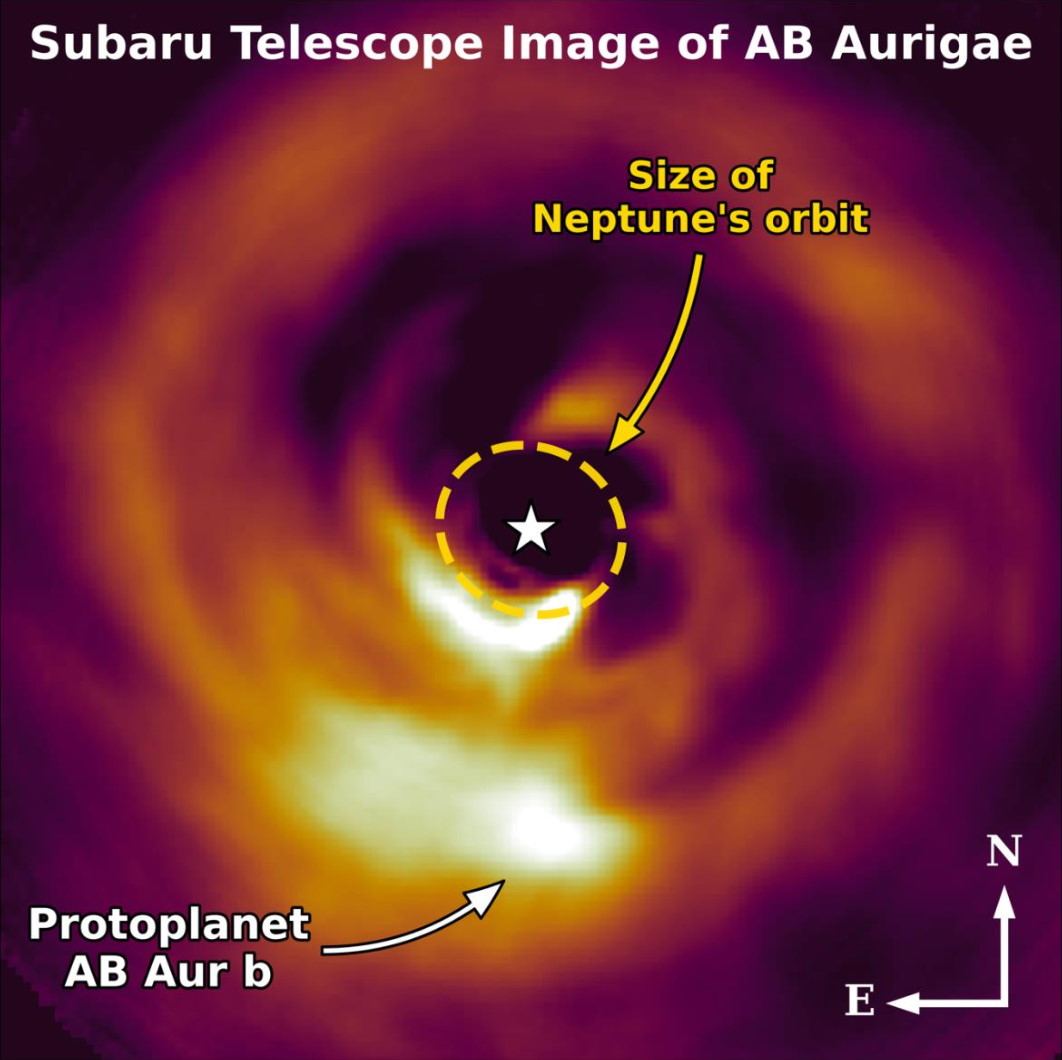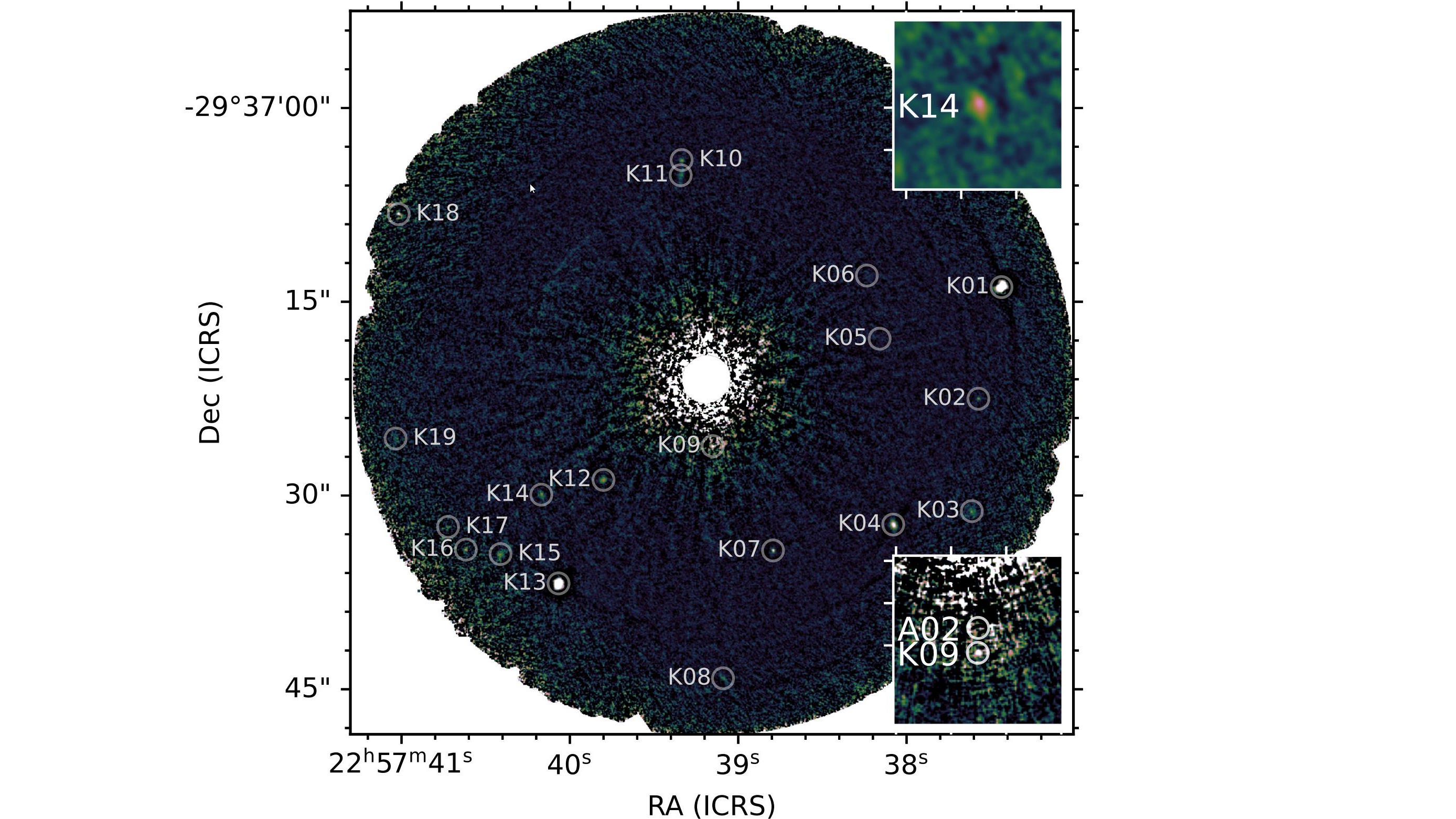First co-orbiting exoplanet hints at our Moon’s origin
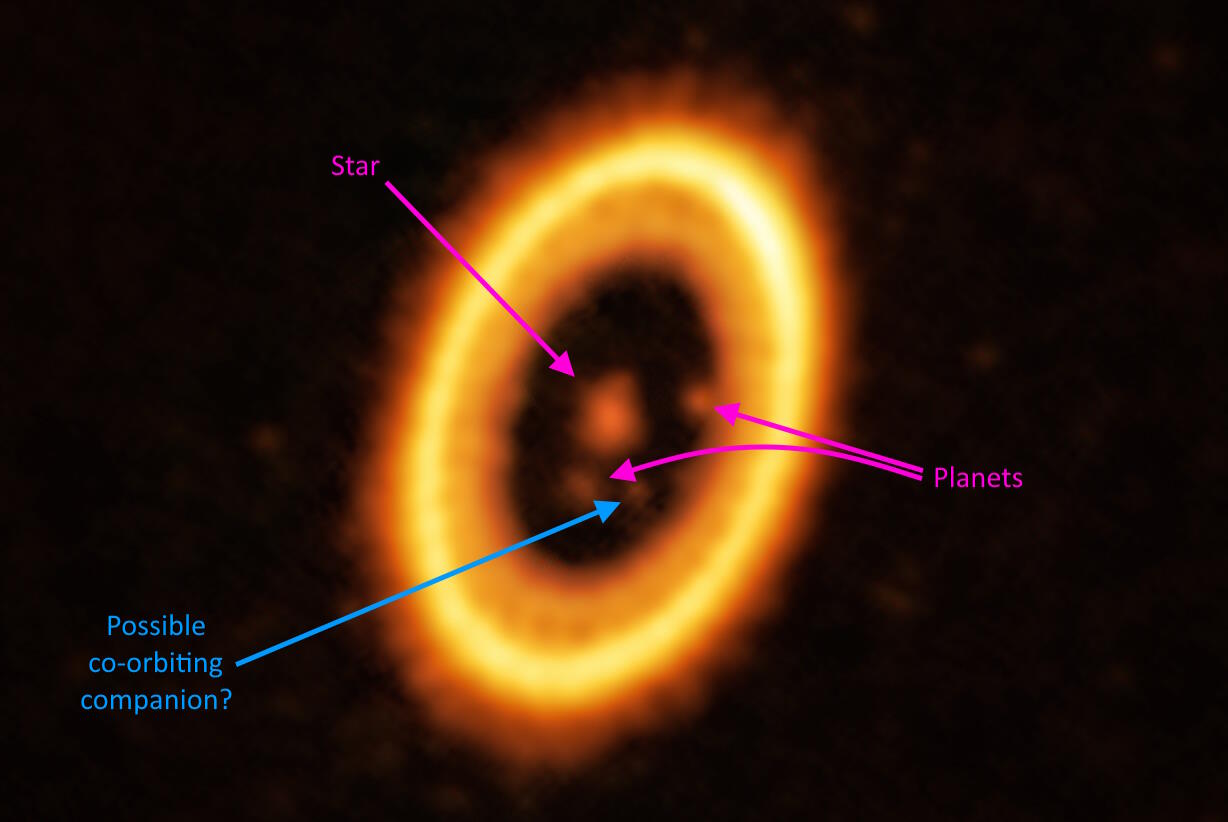
- In the early days of our Solar System’s history, the four inner, rocky worlds were hypothetically joined by a fifth, Mars-sized object: Theia.
- After tens of millions of years passed, proto-Earth and Theia collided, forming our Moon as a result of an early, giant impact.
- Astronomers have just spotted a co-orbiting exoplanetary candidate within the young exoplanetary system PDS 70, suggesting that early, giant impacts may be common throughout the Universe.
When it comes to the story of how our Solar System came to be, some pieces fall into place more readily than others. Most stellar systems form with a protoplanetary disk around them, yielding planets orbiting all in the same plane. The disk gets disrupted by large gravitational imperfection, leading to a mix of planets of various masses: from small, rocky worlds to large, giant ones. Rich lunar systems should form around every giant planet massive enough to collect its own circumplanetary disk, but not around the smaller, rocky worlds.
Yet both Earth and Mars possess moons, with Earth’s Moon being one of the largest in the Solar System, outmassed only by four others: Jupiter’s Ganymede, Callisto, and Io, as well as Saturn’s Titan.
How did our planet wind up with such a massive natural satellite? The leading theory, for over half a century, has been that a massive giant impact, early on in our Solar System’s history, kicked up enough debris to coalesce into our Moon, but only about ~50 million years after the rest of the planets formed. That theory has just gotten a boost from seemingly the most unlikely of places: by looking at a still-forming exoplanetary system. The PDS 70 star system holds a number of important lessons for how our Solar System formed, and the newest data shows that such giant impacts might not even be rare, after all.
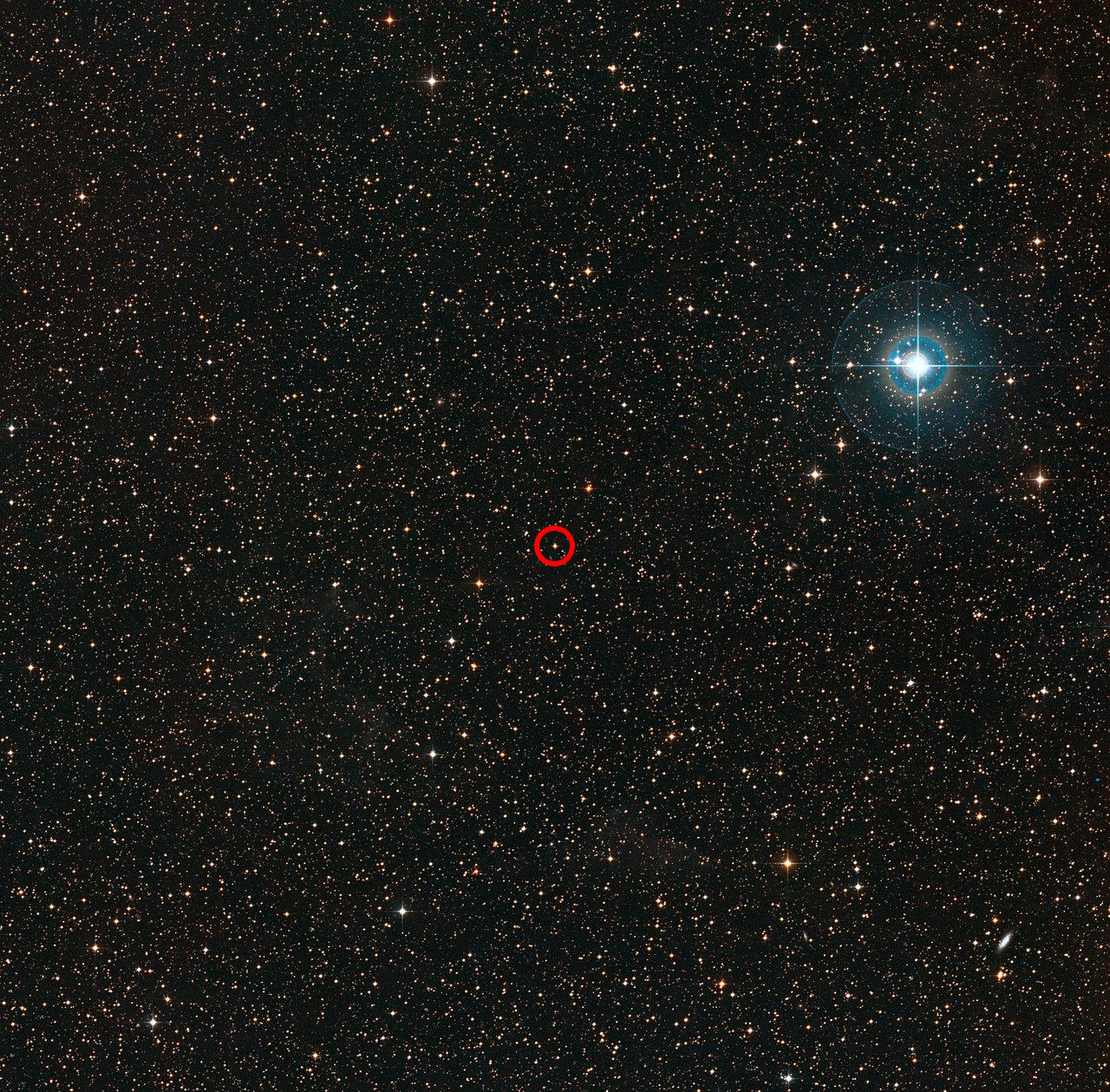
If we want to know how planets form around stars, we ideally want to go back to the earliest stages possible: to when a star and its surrounding planetary system are still forming. Ideally, we’d find a very young star, still with lots of planet-forming material surrounding it, that was both very nearby to us and also possessed a central star that was somewhat comparable in mass to our Sun.
That’s what makes this one particular star, PDS 70, so interesting. Based on the infrared light that it emitted, it was identified as a pre-main sequence star (of the T Tauri type) back in 1992, where it was theorized to be less than 10 million years old and hypothesized to have a protoplanetary disk around it in that same year. It’s properties were thoroughly investigated and measured, and we’ve now determined that:
- the central star, PDS 70 itself, has a mass that’s 76% as large as our Sun’s,
- but is still contracting, with a radius that’s actually 26% larger than our Sun,
- it’s very young, with an estimated age of only 5.4 million years,
- and it’s extremely close by for such a young star, at a distance of merely 370 light-years.
As is typical for a star this young, its brightness also varies periodically by a significant amount: dropping to as little as 75% of its peak brightness in a quasi-periodic, but also a chaotic, fashion.
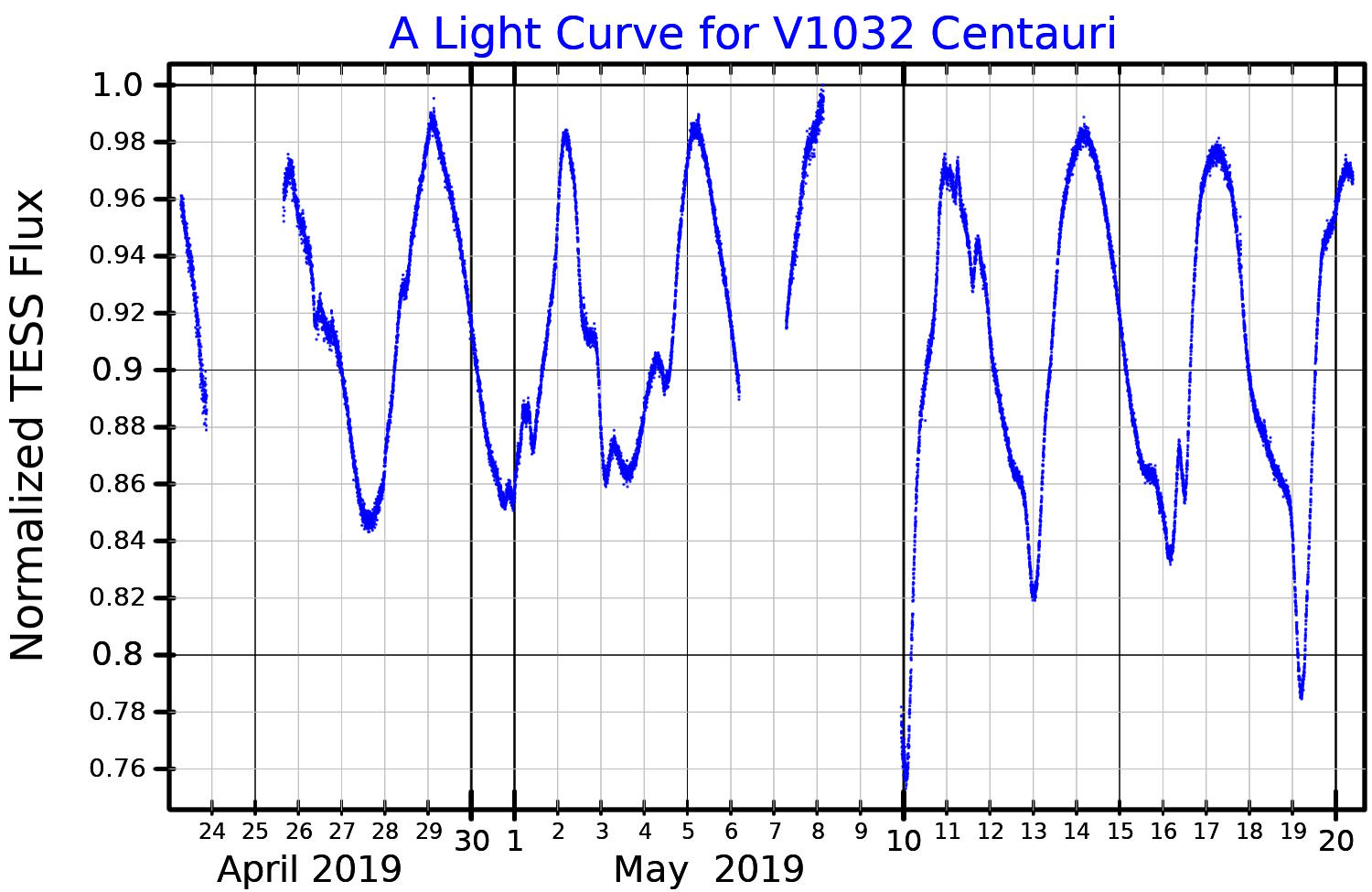
It wasn’t until 2006, however, that we were able to measure the presence of this protoplanetary disk directly: by using a coronagraph attached to one of the European Southern Observatory’s flagship observatories: the Very Large Telescope, or VLT for short. As camera, coronagraph, and adaptive optics technologies continued to improve over the past three decades, we got a better and better view of this young stellar system.
First, we determined the extent of the protoplanetary disk: demonstrating that it extended about ~140 A.U. from the central star (where 1 A.U. is an astronomical unit: the average Earth-Sun distance).
Next, in 2012, we determined the disk doesn’t extend all the way to the innermost regions of the star system itself, but rather peters out about 65 A.U. from the star, and is largely absent in the innermost regions: suggesting the presence of already-formed planets in the inner stellar system.
After that, a 2015 study showed that the inner gap was different for large dust particles and small dust particles: whereas there were no small dust grains in the inner ~65 A.U. of the PDS 70 system, the large dust grains are depleted even farther, as they’re absent from the inner ~80 A.U. of the system. Along with a newly-detected asymmetry in the overall shape of the dust grain gap, this suggested that multiple planets were present.
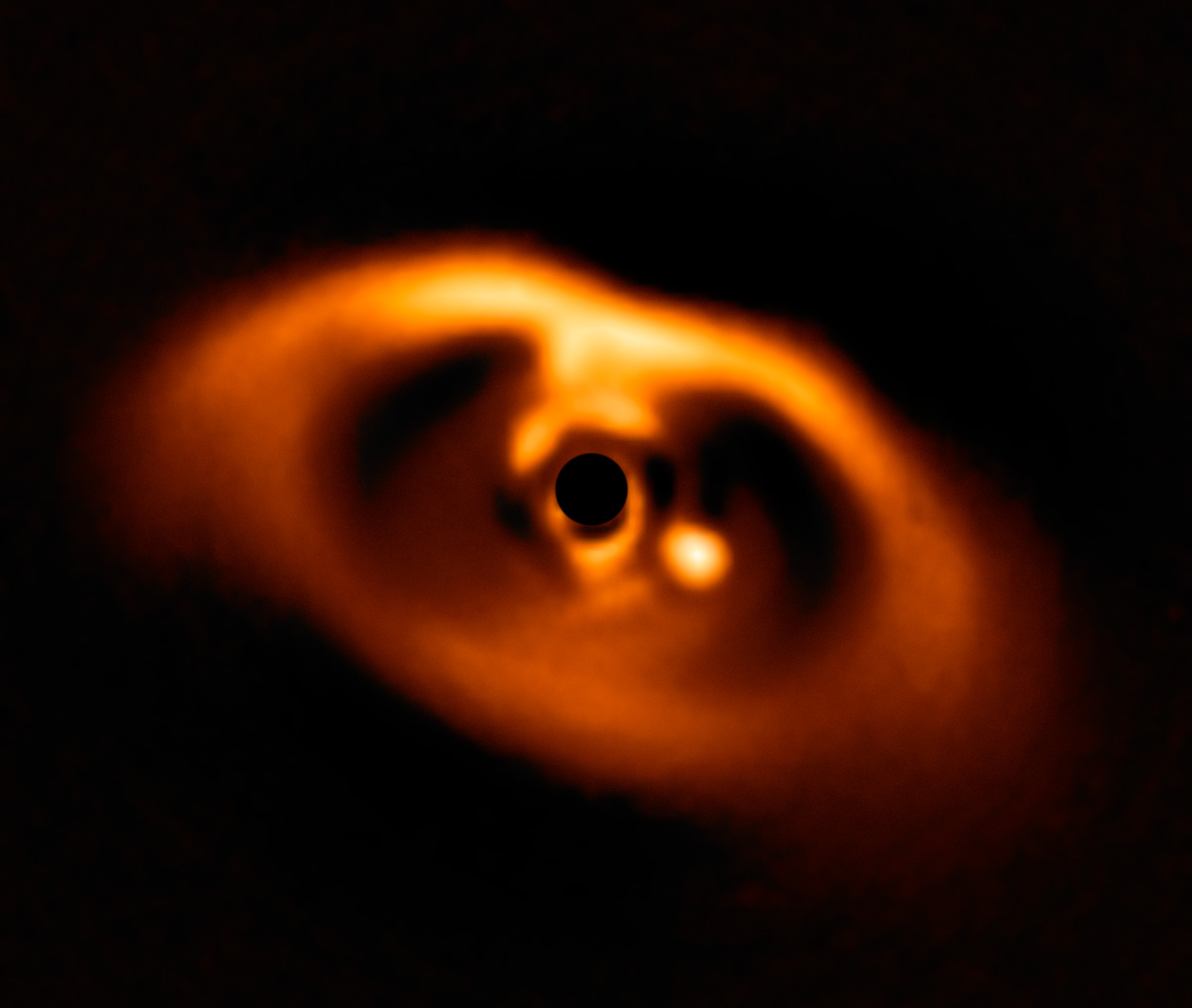
In 2014, the VLT got a significant upgrade, as the SPHERE planet imager was installed. At last, the technology was in place to not simply settle for inferring the existence of young planets around this newly forming star, but to get the key evidence for their existence through direct imaging. In 2018, the first evidence for a planet around this young star was announced. Known as PDS 70b, it’s massive and distant from the central star, with:
- a semimajor axis of 22.7 A.U., placing it at about the distance of Uranus from the Sun,
- an orbital period of 123 years,
- a mass of about seven Jupiter masses,
- and a physical size of about 175% the size of Jupiter.
This “super-Jupiter” planet thus became the first confirmed protoplanet ever directly imaged. The next year, in 2019, it was confirmed to have its own accretion disk, and in that same year, a different instrument aboard the VLT — the MUSE integral field spectrograph — detected a second, outermore protoplanet within the same star system: PDS 70c. This time, the new planet was even farther out, at about the distance of Neptune (~30 A.U.), a little less massive at 4.4 Jupiter masses, but had an even more remarkable property: with the right observatory we could directly image the circumplanetary disk around it.

Just as every massive star that forms ought to form with a circumstellar disk around it — a disk of primitive material that fragments and gravitates to form planets, asteroids, and other massive bodies — every giant planet that forms ought to possess a circumplanetary disk: a disk of material that orbits the newborn planet, typically rotating around the planet in the same fashion that the planet itself rotates on its axis. And just as PDS 70b was the first protoplanet ever to be directly imaged, PDS 70c was the first planet ever seen with a circumplanetary disk around it.
These circumplanetary disks are thought to lead to lunar systems around the gas giant worlds, as they will also experience gravitational instabilities within the disk, which in enough time will lead to a system of moons and rings. There’s enough mass within the circumplanetary disk around PDS 70c for the creation of three large moons around it, about the size of Earth’s moon, indicating that this will probably form a lunar system more like the ones around Jupiter or Saturn than the ones around Uranus or Neptune.
But as fun and compelling as these findings are, they don’t help very much when it comes to the mystery of how rocky worlds, like Earth and Mars, came to possess their moons.

There’s a theory about this, of course. Most working scientists think that the way Earth’s moon was formed was not from a circumplanetary disk dating back to the planet-forming period of our Solar System, but rather came about 50 million years later. The idea is that a giant protoplanet — a Mars-sized body named Theia — collided with the young proto-Earth and merged with it, kicking up an enormous cloud of debris that surrounded the planet for many thousands of years. Over time, one or more massive bodies formed from the gravitational coalescence of this matter, while some fell back to the main planet and the remainder escaped into interplanetary space.
If that sounds like a wild idea, you aren’t the only one to think so. But this doesn’t just agree with simulations, but with a large body of evidence supporting this scenario, including:
- a geochemical analysis of the Moon rocks brought back by the Apollo astronauts,
- the alignment of Earth’s spin with the Moon’s orbit,
- the small size of the Moon’s iron core,
- the depletion of volatile elements on the Moon,
- the large angular momentum of the Moon-Earth system relative to the other rocky planets,
- the identical stable isotope ratios of rocks from the Moon and Earth,
as well as other pieces of evidence.

There’s also a very compelling theory that Mars acquired its pair of moons, Phobos and Deimos, from a giant impact as well. The tremendous differences in topography between Mars’s northern and southern hemispheres suggest a large, ancient impact, while the alignment of Phobos and Deimos with both one another and with Mars’s spin axis indicate that they likely all have a common origin. Although simulations couldn’t reproduce a giant impact resulting in two small moons, they could produce a large, inner moon that would subsequently fall back onto Mars, along with two smaller, outer moons. As of 2016, this is the leading scenario for how Mars got its moons.
Where, though, did these hypothetical protoplanets that would cause such collisions come from?
One idea is that there were initially large numbers of relatively massive protoplanets in our young Solar System, and that as they gravitationally interact, some of them get ejected, some get shot into the Sun, and some wind up colliding with other planets and moons. That idea, although popular, doesn’t have very much in the way of observational support.
But another idea that’s quite compelling is that multiple protoplanets can form within the same approximate orbit. Just as captured objects exist around the L4 and L5 Lagrange points around all of the gas giants and even our own planet, perhaps these locations were once home to massive protoplanets in our own Solar System, before either getting ejected or colliding with the main planetary body in its path.
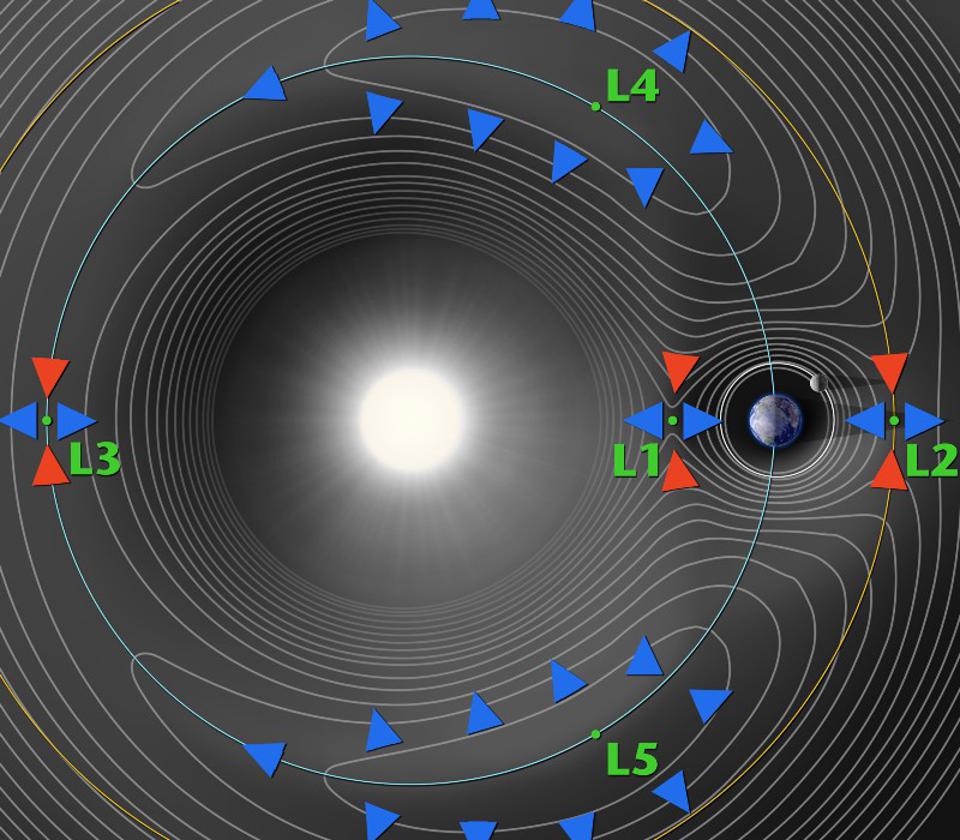
That second scenario just got an incredible boost from an unexpected place: from long-wavelength ALMA observations of the young stellar system around proto-star PDS 70. A large number of features that have been seen before simply pop out brilliantly in this new image:
- The central star, despite being blocked by a coronagraph, still exhibits a bright and nebulous core, perhaps indicating that near the central star itself, planet-formation is still ongoing.
- On the outskirts, the full extent of the remaining protoplanetary disk is visible: extending from ~65 A.U. away from the central star all the way to ~140 A.U. away.
- A very bright ring of material can be seen within this protoplanetary disk, perhaps highlighting where either material is densest, most radiative at the temperatures ALMA is sensitive to, or where it hasn’t yet been “scooped up” by either inner or outer protoplanets.
- Exoplanet PDS 70c is easily visible at the interior of the inner edge of the protoplanetary disk, showcasing just how “tilted” this system is relative to our line-of-sight, rather than being perfectly face-on.
But what’s perhaps most remarkable is that when you examine the location of the innermost known exoplanet in this system, PDS 70b, it looks like there’s a fainter point of light that stands out from the background, co-located in the same orbit.

What, precisely, is that blob of light?
- It could be nothing: just a background object that happens, right now, to be along the same line-of-sight. We believe this occurred once before very recently, when we mistook a background object for a member of the Fomalhaut system’s debris disk.
- It could also be a transient event, like a dust cloud that’s being spit out by this protoplanetary system, which could be the case if, for example, an icy, comet-like object were disintegrating before our eyes. Without observing this object for longer, over time, we can’t be certain.
- But it’s also possible that this is a physically real object in approximately the same orbit as protoplanet PDS 70b. It could be an example of a set of Trojan objects: material that appears to co-orbit with the main planet around a point located either 60° ahead of or behind it in its revolution about its parent star.
- Or, perhaps most excitingly, it could be another protoplanet itself: smaller, fainter, and lower in mass than the main protoplanet.
If the final option is true, this could be a true analogue, although scaled up to a higher planetary mass for the main protoplanet than proto-Earth was, of the hypothetical Earth-Theia system from ~4.5 billion years ago.
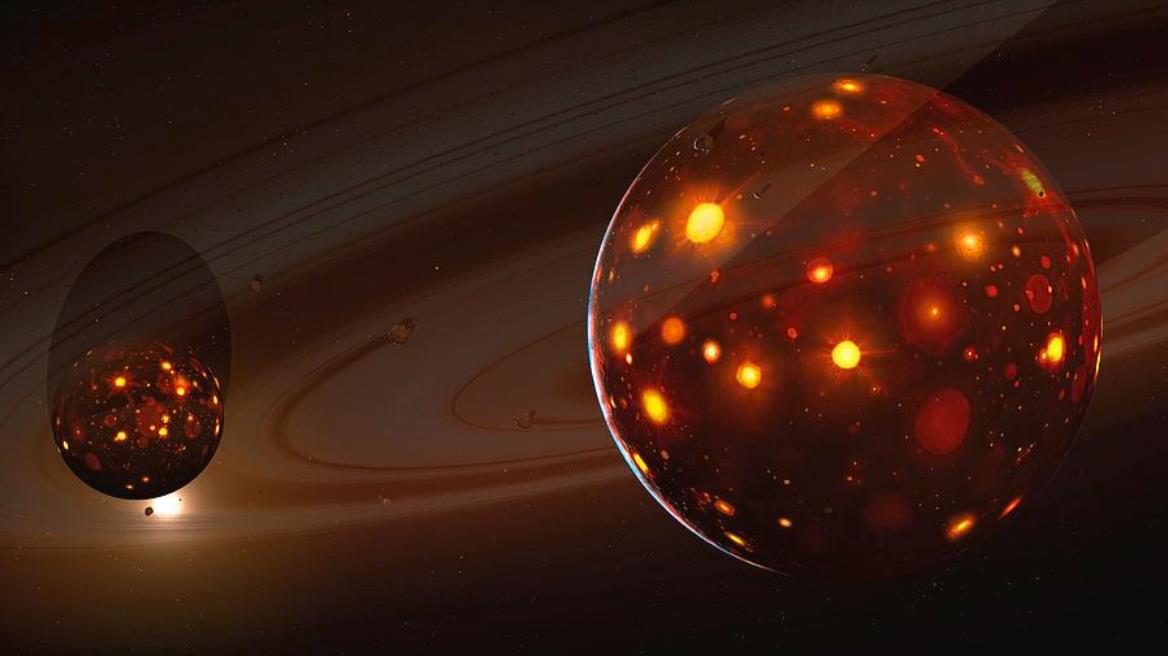
The researchers themselves favor either the third or fourth option, presenting this as the first example of the theoretical population of exo-Trojans, keeping in mind that it may well be a co-orbiting planet that happens to be located around these gravitationally favorable Lagrange points. According to the new paper’s lead author, Olga Balsalobre-Ruza,
“Who could imagine two worlds that share the duration of the year and the habitability conditions? Our work is the first evidence that this kind of world could exist. We can imagine that a planet can share its orbit with thousands of asteroids as in the case of Jupiter, but it is mind blowing to me that planets could share the same orbit.”
As this is the first time we’ve ever investigated a still-forming stellar system that’s this close and this young, the answer, perhaps surprisingly, is that this scenario has been readily imaginable by many for over 20 years now. Orbit-sharing occurs under many circumstances, both in our own Solar System and beyond, but is never absolutely stable over the long-term. As this star system, PDS 70, is only 5.4 million years old, we can be confident that if this observed blob of light really is a companion to PDS 70b, it won’t persist forever.
And just maybe, if scaled-down versions of this giant planet are at all common throughout the Universe, it isn’t just Earth-sized worlds that are common, but Earth-sized worlds with Moon-sized satellites as well.
